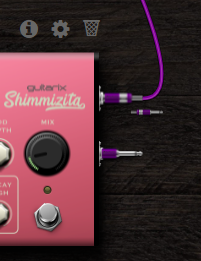`
Chapter I:
Receiving the Dwarf and first impressions of the unit, the GUI and the sound
`
First impressions after receiving, exploring and trying the MOD Dwarf.
Overall:
impressed, excited, full of ideas to try and tweak.
Haven’t played much instruments yet but have been playing around with the virtual and real GUI.
While doing some experimenting, I already learned a lot about the available plugins and what you can do with MIDI
Really glad I participated in this project; it is what I thought it was.
The potential of this technology has much to discover!
(for me but also for you)
A few negative points; mostly minor though.
Strongest one is the noise issue but there seem to be solutions for that I need to explore.
The Package:
++ The Dwarf, nicely in a dedicated sturdy bad, embedded in an extra safety casing.
++ A long and sturdy USB cable.
++ A sufficiently long power adapter
++ A dedicated US stick for backup? Excellent: The devil is in the details!
++ All arrived in safe condition
++ love the feel of the buttons and dials
– Lacking expectation management when it comes to tier 2 reward; Opening the box, Idon’t know what, how, when and whether it active or not. Jon told us in another thread about an upcoming communique though.
Connecting for the first time
++ As soon I was there, The GUI worked very well
++ no software installed; just a browser. Can’t wait to attach my tablet with a specific cable or BT dongle + my BT keyboard and mouse for a minimal studio setup for configuring+testing iterations.
– couldn’t connect to the local address or IP, had to switch a simple setting that was documented in the forum but not on the FAQ about connection issues
Working with the GUI
++ Adding, dragging, connecting is a breeze.
++ for some it might be a drag but being able to map virtually everything to the buttons is great.
++ midi devices, audio effects, all in one screen. I’m still impressed
++ Adding pedalboards from the site was a cool experience.
++ Managing banks and pedalboards into banks went very easy, both on GUI as device itself.
++ Adding files to the file system: super easy! My added IR’s showed up instantly
° Haven’t tried snapshots yet but browsed and had a good feeling what to expect
° didn’t take me too long to map controls to dials/butons but I think I can come up with a more intuitive table to map them
° might need extra footswitches soon.
– sighlty disappointed I couldn’t use the A footswitch in a similar fashion as B and C, turning on and off effects.
– Didn’t see how to have a pedalboard in mutiple banks though (copy paste)
– I instinctively tried to disconnect the outputs but dragging that actually creates a new wire.(perhaps holding SHIFT or CTRL drag could unplug it? :p)
– sometimes, loading a board from the site, it said said ‘victorious’ but the Dwarf dit nothing. retrying often worked
– The pedalboard overview list mode is hard to read because how it is organised
Sound
++ Felt like playing more, that’s a good thing!
++ As soon as I dialed it in right, I discovered some sounds that will need little tweaking to become usable sounds on my board.
++ Had some sweet “edge of breakup/breakup sounds” sounds that sounded great for Hendrixy clean stuff
° with a good “unified output” workflow, I will be able to do more and better testing
– instalty had rather high pitched noise. only dwarf connected to outlet, guitar going in in input 1; cable from output 1 going to input amp. Even with the suggested ground loop fix followed by reboot. Suppose I’ll need to try the “different PSU” scenario?
– I found out the hard way the pedalboards all had different levels of output. Is there a way/suggested workflow to normilze this? I had to dial my Blues Deluxe down to the lowsest possible setting to have quiet test volume.
– Getting an “organic” drive sound was ok but going for high gain without sounding like a hard clipping microwave took some effort.
To-Do for me now:
- Find a workflow to make out output volumes similar
- get to know more options (looper etc, was there a “recorder” device plugin already?)
- Get my first real personal and usable board (and share it)
- test vocals
- test acoustic guitar
- test bass
- test snapshots
- test 4 cable setups with effect loop on amp
- learn more about using IR’s
- buy a midi controller keyboard and start learning piano
 | For me it’s a good way to log my experiments.
| For me it’s a good way to log my experiments. It would be the least of my worries if I would be buyting and trying a different PSU. We’ll see, no showstopper for now!
It would be the least of my worries if I would be buyting and trying a different PSU. We’ll see, no showstopper for now! … 3 effect buttons will be very useful. If needed page selection could be done by knob or external midi.
… 3 effect buttons will be very useful. If needed page selection could be done by knob or external midi.




